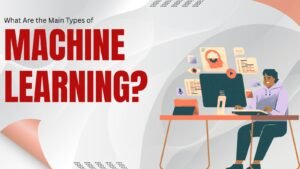Today, machines can learn, think, and even make decisions. But how does this happen? The answer lies in the types of machine learning, a core part of modern technology. But if you want to learn AI and machine learning in a simple and fun way. Here, we’ll break down each type. Also, if you’re curious about real-world learning, you’ll like the AI and machine learning workshops and ML capacity programs by Resilient Foundation that turn theory into hands-on skills.
What Are the Main Types of Machine Learning?
There are four major types of machine learning: supervised, unsupervised, semi-supervised, and reinforcement learning. Firstly, each one works differently; yet, together, they show what makes machine learning unique in solving real problems across many fields.

Supervised Learning: Learn with Labelled Data
In supervised learning, machines learn from data that already has answers (called labels). Because of that, it becomes easier to train machines for real tasks. Here’s how it works:
- Labelled Input and Output: The machine receives input data along with the correct output.
- Learning by Matching: It learns by trying to match inputs with correct outputs.
- Used for Prediction: People mostly use it for tasks like predicting prices, emails, diseases, and more.
- Examples: Image recognition, spam email detection, and house price prediction.
- Data Needed: Needs a large amount of labelled data to work well.
If you want to understand the basics of the types of machine learning, start with supervised learning—it’s the easiest. Resilient Foundation explains it step-by-step in its AI and machine learning workshops and makes hard topics easy for everyone.
Unsupervised Learning: Let the Machine Find Patterns
In unsupervised learning, the machine receives data without labels. Thus, it must find patterns or groups by itself. Here are its key features:
- No Labels: There are no answers given; the machine has to guess.
- Pattern Discovery: It finds hidden patterns, groups, or trends in the data.
- Useful for Clustering: It helps in grouping customers, finding fraud, and more.
- Examples: Customer segmentation, product recommendations, and social media trends.
- Needs Smart Algorithms: Because no labels are given, the machine needs clever methods.
This method, thus, shows what makes machine learning unique—its ability to make sense of unknown data. Also, Resilient Foundation uses this type in its ML capacity programs, thereby helping learners explore real-life data problems.
Semi-Supervised Learning: The Best of Both Worlds
Sometimes, data has a few labels; however, most of it is unlabeled. In that case, hence, we use semi-supervised learning. Yet, it’s a smart middle path. Here’s why it matters:
- Mix of Labelled and Unlabeled Data: The machine uses all the data to learn, even when only some of it has labels.
- Saves Time and Cost: Because of that, it reduces the need to label all data.
- Improves Accuracy: More data means better results, even with fewer labels.
- Examples: Face recognition, medical imaging, search engines.
- Smart Use of Resources: It works well when labels are costly to get.
This type of machine learning is practical in the real world, where labelled data is hard to find. Also, Resilient Foundation’s AI and machine learning workshops, for instance, show how to apply this type in daily tech. As a result, they help you learn AI and machine learning through hands-on experience.
Reinforcement Learning: Learn from Rewards and Penalties
This type teaches machines through experience, like how we learn from rewards or mistakes. Thus, it works best for decision-making over time. Also, key points include:
- Learning by Doing: The machine acts, gets feedback (reward or penalty), and learns.
- Trial and Error: It tries many actions and learns which one works best.
- Used in Games and Robots: This is great for tasks with steps or time, like games.
- Examples: Self-driving cars, chess-playing bots, and robot navigation.
- Continuous Learning: The machine keeps learning and improving with more tries.
This type shows clearly what makes machine learning unique—its power to learn on the go. At Resilient Foundation, we teach this with interactive games and simulations in our ML capacity programs, so learners can enjoy and grow at the same time.

